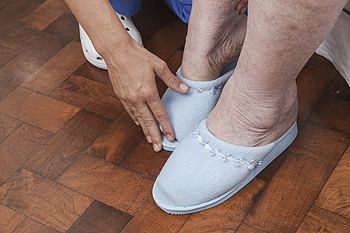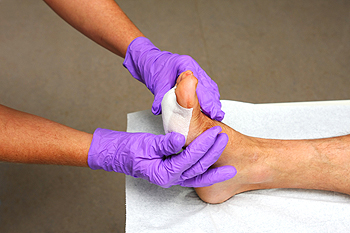

As time passes, the body undergoes natural changes, and our feet are no exception. Subjected to a lifetime of impact, weight-bearing and pressure, your feet gradually transform, affecting their strength and resilience. One noticeable change brought on by aging is the thinning of the skin, reducing natural cushioning and making the feet more vulnerable to damage. Joints in the feet undergo wear and tear, leading to conditions like osteoarthritis. Joints become less flexible, causing the foot to lose its springiness and ability to absorb impact. Muscle strength, which peaked in your 20s and early 30s, gradually diminishes with age. Regular exercise slows this decline and helps to maintain overall foot health. Swelling, a common issue with age, increases pressure on the foot's structures. Poor circulation, often associated with conditions such as atherosclerosis, affects the blood supply to the feet and reduces their ability to repair minor injuries quickly. Toenails also undergo changes, becoming thicker and more brittle as growth slows. Conditions like hypothyroidism and peripheral arterial disease can make this worse. For help in managing foot problems associated with aging, it is suggested that you make an appointment with a podiatrist.
Proper foot care is something many older adults forget to consider. If you have any concerns about your feet and ankles, contact Dr. Harris L. Klear from Burlington County Podiatry Associates. Our doctor can provide the care you need to keep you pain-free and on your feet.
The Elderly and Their Feet
As we age we start to notice many changes in our body, but the elder population may not notice them right away. Medical conditions may prevent the elderly to take notice of their foot health right away. Poor vision is a lead contributor to not taking action for the elderly.
Common Conditions
Susceptible Infections
Diabetes and poor circulation can cause general loss of sensitivity over the years, turning a simple cut into a serious issue.
If you have any questions please feel free to contact one of our offices located in Marlton and Delran, NJ . We offer the newest diagnostic and treatment technologies for all your foot and ankle needs.

Chronic wounds on the lower legs, feet, and toes demand a specialized approach from podiatrists to ensure optimal healing. The process begins with cleaning of the wound and removing any debris. In cases of traumatic injury, a podiatrist may recommend a tetanus vaccination to prioritize your safety. This foot doctor may surgically remove dead skin and close wounds with stitches or staples. Dressing choices for chronic wounds are critical, often leaning toward moist dressings tailored to specific wound characteristics. Vigilant monitoring for signs of infection is a key responsibility, with prescribed antibiotics and antimicrobial dressings essential for effective control. A thorough review of patient medications and adjusting as needed, is essential for patient safety. Specific wounds like ulcers may require specialized treatments, including antibiotics or skin grafts. In cases where poor blood supply hampers healing, a podiatrist may recommend vascular surgery to improve circulation. If you are experiencing chronic foot wounds, it is suggested that you schedule an appointment with a podiatrist for a comprehensive treatment plan.
Wound care is an important part in dealing with diabetes. If you have diabetes and a foot wound or would like more information about wound care for diabetics, consult with Dr. Harris L. Klear from Burlington County Podiatry Associates. Our doctor will assess your condition and provide you with quality foot and ankle treatment.
What Is Wound Care?
Wound care is the practice of taking proper care of a wound. This can range from the smallest to the largest of wounds. While everyone can benefit from proper wound care, it is much more important for diabetics. Diabetics often suffer from poor blood circulation which causes wounds to heal much slower than they would in a non-diabetic.
What Is the Importance of Wound Care?
While it may not seem apparent with small ulcers on the foot, for diabetics, any size ulcer can become infected. Diabetics often also suffer from neuropathy, or nerve loss. This means they might not even feel when they have an ulcer on their foot. If the wound becomes severely infected, amputation may be necessary. Therefore, it is of the upmost importance to properly care for any and all foot wounds.
How to Care for Wounds
The best way to care for foot wounds is to prevent them. For diabetics, this means daily inspections of the feet for any signs of abnormalities or ulcers. It is also recommended to see a podiatrist several times a year for a foot inspection. If you do have an ulcer, run the wound under water to clear dirt from the wound; then apply antibiotic ointment to the wound and cover with a bandage. Bandages should be changed daily and keeping pressure off the wound is smart. It is advised to see a podiatrist, who can keep an eye on it.
If you have any questions, please feel free to contact one of our offices located in Marlton and Delran, NJ . We offer the newest diagnostic and treatment technologies for all your foot care needs.

Whether you are new to running or a seasoned athlete, understanding your running style and making necessary improvements can significantly improve your running experience. A gait analysis is a measuring stick for your running form, helping you to understand your unique gait and reduce the chances of injury. A gait analysis plays a vital role in enhancing impact absorption and the overall efficiency of your movement. By identifying areas that require attention, you can improve these weaknesses to become a more efficient and injury resistant runner. Among the areas that would be considered are foot strike and position, pronation, running posture, cadence, and stride. Footwear is a critical consideration for runners, and an analysis can help determine the type of running shoes that best suits your unique gait and biomechanics. Additionally, a gait analysis can identify whether custom orthotics designed by a podiatrist would be beneficial. In conclusion, a running gait analysis is a valuable tool that can help you to achieve your goals. To find out more, it is suggested that you make an appointment with a podiatrist.
All runners should take extra precaution when trying to avoid injury. If you have any concerns about your feet, contact Dr. Harris L. Klear of Burlington County Podiatry Associates. Our doctor will treat your foot and ankle needs.
How to Prevent Running Injuries
There are a lot of mistakes a runner can make prior to a workout that can induce injury. A lot of athletes tend to overstretch before running, instead of saving those workouts for a post-run routine. Deep lunges and hand-to-toe hamstring pulls should be performed after a workout instead of during a warmup. Another common mistake is jumping into an intense routine before your body is physically prepared for it. You should try to ease your way into long-distance running instead of forcing yourself to rush into it.
More Tips for Preventing Injury
If you have any questions, please feel free to contact one of our offices located in Marlton and Delran, NJ . We offer the newest diagnostic and treatment technologies for all your foot care needs.

After one breaks an ankle, weight bearing restrictions can be imposed to facilitate proper healing. These restrictions encompass non weight bearing, where no weight can be placed on the leg. Toe touch weight bearing, which involves minimal toe contact with the ground can be effective for balancing. Partial weight bearing allows for a specific percentage of weight to be placed on the leg, and is generally managed by using crutches. Compliance with these restrictions is vital to promote the healing process. Disregarding them can lead to complications or delayed recovery. Signs of non compliance can include increased pain, swelling, or redness in the leg. If you have a broken ankle, it is suggested that you make an appointment with a podiatrist who can recommend the weight bearing protocols that will best help you.
Broken ankles need immediate treatment. If you are seeking treatment, contact Dr. Harris L. Klear from Burlington County Podiatry Associates. Our doctor can provide the care you need to keep you pain-free and on your feet.
Broken Ankles
A broken ankle is experienced when a person fractures their tibia or fibula in the lower leg and ankle area. Both of these bones are attached at the bottom of the leg and combine to form what we know to be our ankle.
When a physician is referring to a break of the ankle, he or she is usually referring to a break in the area where the tibia and fibula are joined to create our ankle joint. Ankles are more prone to fractures because the ankle is an area that suffers a lot of pressure and stress. There are some obvious signs when a person experiences a fractured ankle, and the following symptoms may be present.
Symptoms of a Fractured Ankle
If you suspect an ankle fracture, it is recommended to seek treatment as soon as possible. The sooner you have your podiatrist diagnose the fracture, the quicker you’ll be on the way towards recovery.
If you have any questions, please feel free to contact one of our offices located in Marlton and Delran, NJ . We offer the newest diagnostic and treatment technologies for all your foot care needs.